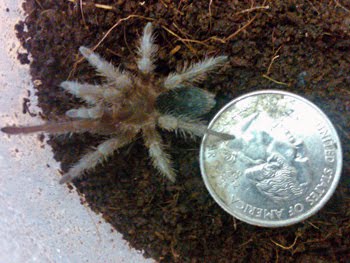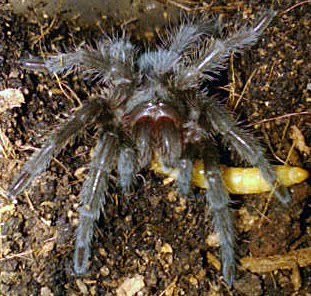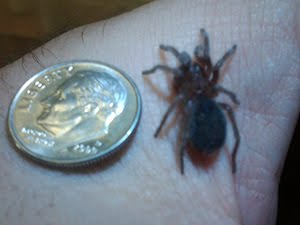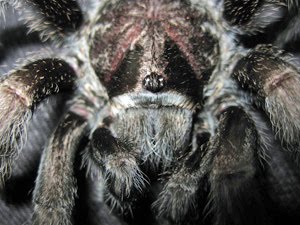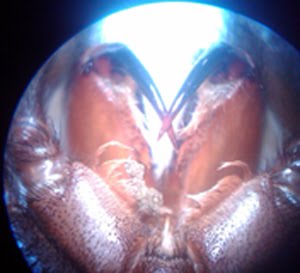Grammostola pulchra classification and natural habitat:
Scientific Classification
Kingdom: Animalia
Phylum: Arthropoda
Class: Arachnida
Order: Araneae
Suborder: Mygalomorphae
Family: Theaphosidae
Genus: Grammostola
Species: G. pulchra
(Mello-Leitão, 1921)
Known as the Brazilian Black Tarantula, mature specimens are almost entirely black. The species is prized in the pet trade due to its long life, reputation as a docile and gentle tarantula, a reduced tendency to kick urticating hairs, and let us not overlook the deep black color. Taking up to seven years to reach sexual maturity(6-8 inch leg span). Because of a ban on the export of wild caught specimens, its somewhat slow growth, and difficulties with captive breeding mature specimen are generally expensive. Females can live ~20 years; mature males tend to live much longer after their ultimate molt than the average male tarantula.
Grammostola pulchra is a terrestrial tarantula native to the Pampas (temperate grasslands covering some 777,000 square kilometers) in Brazil and Uruguay (see image). The Uruguayan savanna is a subtropical grassland, also known as the Brazilian-Uruguayan savanna, one of three Pampa Eco-regions, lies east of the Uruguay River in the South Temperate Zone, and includes all of Uruguay and the southern portion of Brazil's state of Rio Grande do Sul.
Tropical and subtropical grasslands, savannas, and shrub lands are a grassland biome located in semi-arid to semi-humid climate regions of subtropical and tropical latitudes. Grasslands are dominated by grass and other herbaceous plants. Savannas are grasslands with scattered trees. Shrub lands are dominated by woody or herbaceous shrubs.
Frequent wildfires in the Brazilian-Uruguayan savanna ensure that only small plants such as grasses flourish, and trees are rare. The dominant vegetation types are grassy prairie and grass steppe in which numerous species of the grass genus Stipa are particularly conspicuous. "Pampas Grass" (Cortaderia selloana) is an iconic species of the Pampas. Vegetation typically includes perennial grasses and herbs. Different strata of grasses occur because of gradients of water availability.
The temperate climate is mild with four relatively well-marked seasons, and precipitation of 45 and 150 centimeters (20 to 60 inches), more or less evenly distributed throughout the year, but occasional droughts can occur. The winter months, June to September, are characterized by heavy rains and by a cold southwesterly wind, which sometimes lowers the temperature to the freezing point, especially in the mountainous municipalities, where snowfalls can occur. In summer, the temperature rises to 30°C (86°F).
Winters are cool to mild and summers are very warm and humid. Rainfall is fairly uniform throughout the year but is a little heavier during the summer. Annual rainfall is heaviest near the coast and decreases gradually further inland. Rain during the late spring and summer usually arrives in the form of brief heavy showers and thunderstorms. More general rainfall occurs the remainder of the year as cold fronts and storm systems move through. Although cold spells during the winter often send nighttime temperatures below freezing, snow is quite rare. In most winters, a few light snowfalls occur over inland areas.
Rio Grande del Sul Climate
Brazil Climate
Pampas
Humid Pampa
Climate of Uruguay/Brazil, G. pulchra habitat. (based on ~15 year average)
Average Daily Temp. ~75F
Average High Temp. ~84F
Average Low Temp. ~67F
Average Relative Humidity: ~64%
Average Annual Precip. ~50in.
Source: Weatherbase
Wild G. pulchra in its burrow
photo by W. Schepanski
Wild G. pulchra in a threat posture
photo by W. Schepanski
Tarantula Anatomy
 |
| Copyright Tarantulasus.com created by Jeremy Guay |
 |
| Source Tarantulasus.com |








